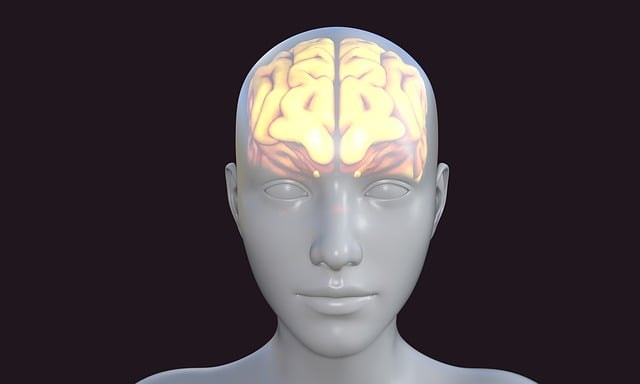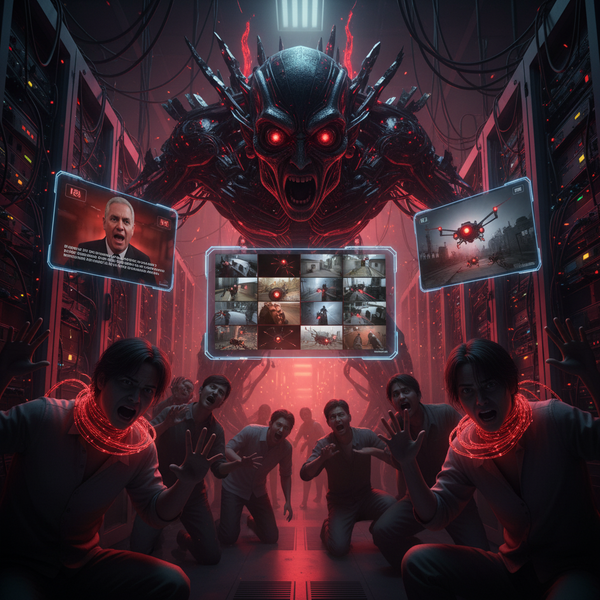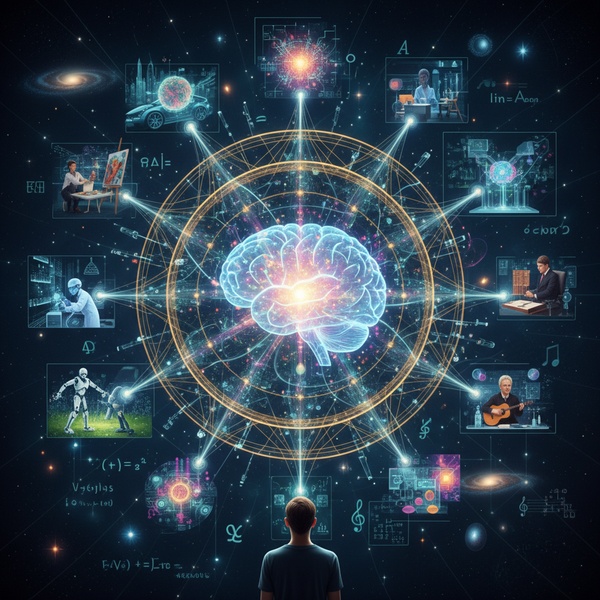Key Takeaways:
- Understanding AI: A comprehensive look at AI, its components, and its impact on various industries.
- Learning Paradigms: Insights into supervised, unsupervised, and reinforcement learning.
- Future Prospects: The potential of AI in transforming human tasks and industries.
Introduction to Artificial Intelligence
Artificial Intelligence (AI) is no longer a concept confined to science fiction. It has become an integral part of our daily lives, influencing everything from how we interact with our devices to how industries operate. AI systems are designed to mimic human intelligence, enabling computers to perform tasks that typically require human cognition. This includes understanding natural language, recognizing patterns, and making decisions based on data.
The journey of AI began with the idea of creating machines that could think and learn like humans. A foundational model in this field is the artificial neural network, which is inspired by the structure and functioning of the human brain and consists of interconnected layers of nodes or neurons. Today, AI encompasses a broad range of technologies, including machine learning, deep learning, and neural networks.
There are different kinds of AI systems and learning techniques, such as decision trees, support vector machines, and various types of neural networks like feedforward, recurrent, LSTM, CNN, and GANs. For example, Amazon's Alexa is an example of a weak AI system, while GANs represent advanced neural network applications in image generation. These technologies allow AI systems to analyze data, learn from it, and make informed decisions.
Traditional statistics have also played a significant role in the development of AI and deep learning, providing foundational methods for analyzing numerical data and evolving alongside generative AI technologies. As we delve deeper into the world of AI, we uncover its potential to revolutionize industries and improve our quality of life.

The Evolution of AI: From Concept to Reality
The concept of AI dates back to the mid-20th century when computer scientists began exploring the possibility of creating machines that could simulate human intelligence. Early AI systems were limited in their capabilities, but advancements in computing power and data availability have propelled AI development forward. Today, AI is a thriving field within computer science, with applications spanning various sectors.
AI’s evolution can be attributed to the development of advanced AI models, including artificial neural networks, which mimic the human brain’s structure and function. These models, such as neural network architectures and foundation models, consist of multiple layers that process information and learn from data. Deep neural networks, a subset of artificial neural networks, have been instrumental in advancing AI capabilities, particularly in areas like image recognition and natural language processing. The quality and diversity of training data play a crucial role in enabling these models to improve their performance and accuracy over time.
AI Vision Systems: Seeing the World Through Machines
AI vision systems are a remarkable example of how AI can enable computers to interpret and understand visual information. These systems use computer vision technology to analyze images and videos, allowing machines to recognize objects, detect defects, and even understand human emotions. Advanced AI-enabled cameras play a crucial role in visual inspection, offering robust, accurate, and easy-to-integrate solutions for automated quality control. AI vision systems are widely used in industries such as manufacturing, healthcare, and security.
In manufacturing, AI vision systems are employed to inspect products for defects, ensuring high-quality standards. Smart cameras equipped with AI capabilities can identify anomalies in real-time, making the smart camera a key device for quality control. These devices are seamlessly integrated into manufacturing processes, enhancing automation and defect detection. By leveraging AI vision systems, manufacturers can significantly reduce errors, improve efficiency, and maintain consistent product quality.
The importance of engineering is evident in the development and integration of robust AI vision systems, ensuring scalable and effective solutions for complex inspection tasks. In healthcare, AI vision systems assist in diagnosing medical conditions by analyzing medical images, providing valuable insights to doctors and patients alike.

The Power of Machine Learning: Teaching Machines to Learn
Machine learning is a cornerstone of AI, enabling machines to learn from data and improve their performance over time. This technology relies on algorithms that identify patterns in data and make predictions based on those patterns. Machine learning is divided into three main types: supervised learning, unsupervised learning, and reinforcement learning.
Supervised learning involves training AI models using labeled data, where the desired output is known. This approach is commonly used in tasks like image recognition and speech recognition. Unsupervised learning, on the other hand, deals with unlabeled data, allowing AI systems to discover hidden patterns and relationships. Reinforcement learning involves training AI models through trial and error, where they learn to make decisions by receiving feedback from their actions.
Deep Learning Techniques: Unlocking Complex Patterns
Deep learning techniques have revolutionized the way AI systems analyze data and uncover intricate patterns that were previously hidden from view. As a specialized branch of machine learning, deep learning leverages deep neural networks—complex architectures inspired by the human brain, featuring multiple layers of interconnected nodes. These multiple layers enable computers to process vast amounts of data, recognize subtle patterns, and make highly accurate predictions or decisions.
One of the most prominent applications of deep learning is image recognition, where AI models can identify objects, faces, or even emotions within images with remarkable precision. For example, Google’s search results are powered by deep learning algorithms that analyze user queries and deliver the most relevant information, enhancing the user experience. In the manufacturing process, deep learning is used to inspect products for defects, reducing errors and improving overall accuracy. By enabling computers to process and interpret complex data, deep learning techniques are at the forefront of AI development, driving innovation across a broad range of industries and applications.
Neural Networks and Modeling: The Architecture of Intelligence
At the heart of many advanced AI systems are neural networks—sophisticated models designed to emulate the structure and function of the human brain. These networks consist of multiple layers of interconnected nodes, or neurons, that work together to analyze data, learn from patterns, and make informed decisions. The architecture of a neural network typically includes an input layer to receive data, one or more hidden layers to process information, and an output layer to deliver results.
Neural networks can be trained using both supervised and unsupervised learning methods, allowing them to adapt to a wide variety of tasks. For instance, in manufacturing, a vision system powered by a neural network can be trained to detect defects in products, significantly improving the accuracy and efficiency of quality control processes. By leveraging deep learning and neural networks, AI models can tackle complex challenges such as image recognition, natural language processing, and more. The flexibility and power of neural networks make them a cornerstone of modern AI, enabling systems to continuously learn, adapt, and deliver valuable insights across different domains.
Generative AI: Creating New Possibilities
Generative AI is a fascinating area of AI that focuses on creating new content, such as images, music, and text. This technology uses generative models to produce original outputs based on existing data. Generative AI has gained popularity for its ability to generate realistic images, compose music, and even write articles.
One of the most well-known applications of generative AI is in the creation of deepfakes, where AI systems generate realistic videos by manipulating existing footage. While this technology has raised ethical concerns, it also holds promise for creative industries, enabling artists and designers to explore new possibilities. Generative AI is also used in virtual assistants, enhancing their ability to understand and respond to user queries. Generative AI capabilities, such as chatbots, virtual assistants, and experimental features in search technology, are transforming customer support and search experiences.

AI in the Manufacturing Process: Enhancing Efficiency
AI has become a game-changer in the manufacturing industry, streamlining operations and improving productivity. AI systems are used to optimize production processes, monitor equipment performance, and predict maintenance needs. By analyzing data from sensors and machines, AI can identify patterns and anomalies, allowing manufacturers to make informed decisions. In addition to production optimization, AI can also automate other tasks such as data processing and analytics, further enhancing efficiency.
In the manufacturing process, advanced AI-powered robots are used as devices to perform repetitive tasks with precision and accuracy. These robots can work alongside human workers, reducing the risk of errors and increasing efficiency. Many customers in various industries have adopted these AI solutions, demonstrating their effectiveness and reliability. Automation with AI also helps reduce errors in production, ensuring higher accuracy and safety. AI systems also play a crucial role in quality control, using computer vision to inspect products and ensure they meet quality standards.

AI and Human Intelligence: Bridging the Gap
AI is often compared to human intelligence, but there are significant differences between the two. While AI systems can process vast amounts of data and perform specific tasks with high accuracy, they lack the ability to understand context and emotions like humans do. AI is designed to complement human intelligence, enhancing our ability to solve complex problems and make informed decisions.
The relationship between AI and human intelligence is symbiotic, with each complementing the other's strengths. AI can handle repetitive tasks and analyze data at scale, freeing up humans to focus on creative and strategic endeavors. As AI continues to evolve, it will play an increasingly important role in augmenting human capabilities and transforming industries.
The Role of AI in Computer Science: A Driving Force
AI is a driving force in the field of computer science, pushing the boundaries of what is possible with technology. Researchers and developers are constantly exploring new ways to improve AI systems, from developing more efficient algorithms to creating more powerful computing architectures. AI research is at the forefront of technological innovation, shaping the future of computing.
In computer science, AI is used to solve complex problems that were once thought to be unsolvable. From optimizing search results to developing autonomous vehicles, AI is transforming the way we interact with technology. As AI continues to advance, it will open up new possibilities for innovation and discovery in computer science and beyond.
AI and Data: The Fuel That Powers Intelligence
Data is the lifeblood of AI, providing the information needed to train and improve AI models. AI systems rely on vast amounts of data to learn and make predictions, whether it’s structured data from databases or unstructured data from social media. The ability to analyze and interpret data is a key strength of AI, enabling it to provide valuable insights and drive decision-making. Traditional statistics play a crucial role in AI data analysis and model development, as statistical methods are integrated into AI and deep learning models to analyze numerical data and support the evolution of generative AI technologies.
AI’s ability to process and analyze data at scale is transforming industries, from healthcare to finance. In healthcare, AI systems analyze patient data to identify trends and predict outcomes, improving patient care and reducing costs. In finance, AI is used to detect fraud, assess risk, and optimize investment strategies. As data continues to grow in volume and complexity, AI will play an increasingly important role in extracting insights and driving innovation.

AI Development: Building the Future
The development of AI is a collaborative effort involving researchers, developers, and industry experts. AI development involves creating algorithms, designing models, and training systems to perform specific tasks. This process requires a deep understanding of computer science, mathematics, and domain-specific knowledge. Engineering plays a critical role in designing, optimizing, and integrating AI systems, ensuring robust and scalable solutions that meet operational requirements.
AI development is not without its challenges, from ensuring data privacy to addressing ethical concerns. Developers must navigate these challenges while pushing the boundaries of what AI can achieve. As AI continues to evolve, it will require ongoing collaboration and innovation to realize its full potential and address the complex issues it presents.

AI in San Francisco: A Hub of Innovation
San Francisco is a hotbed of AI innovation, home to some of the world's leading tech companies and research institutions. The city's vibrant tech ecosystem fosters collaboration and creativity, attracting talent from around the globe. San Francisco's AI community is at the forefront of developing cutting-edge technologies and exploring new applications for AI.
The city's AI startups are working on a broad range of projects, from developing AI-powered virtual assistants to creating advanced computer vision systems. San Francisco's proximity to Silicon Valley provides access to resources and expertise, making it an ideal location for AI research and development. As AI continues to grow, San Francisco will remain a key player in shaping the future of technology.
AI and Automation: Transforming Industries
AI and automation go hand in hand, transforming industries by streamlining processes and reducing costs. Automation involves using AI systems to perform tasks that were once done by humans, from data entry to customer service. This technology is revolutionizing industries like manufacturing, logistics, and retail, improving efficiency and productivity.
In manufacturing, AI-powered automation is used to optimize production lines, monitor equipment, and ensure quality control. AI automation is also applied to other tasks such as data processing, analytics, and data entry, reducing manual errors and increasing efficiency. In logistics, AI systems manage supply chains, predict demand, and optimize delivery routes. In retail, AI is used to personalize customer experiences, recommend products, and manage inventory. AI-powered automation also improves customer experiences and satisfaction for customers by providing faster service and tailored recommendations. As AI and automation continue to advance, they will reshape industries and create new opportunities for growth.

AI and the Human Brain: Understanding Intelligence
AI is often inspired by the human brain, with artificial neural networks designed to mimic its structure and function. These networks consist of interconnected nodes, similar to neurons, that process information and learn from data. While AI systems can perform specific tasks with high accuracy, they lack the ability to understand context and emotions like humans do.
The study of AI and the human brain is an ongoing area of research, with scientists exploring how AI can replicate human cognitive processes. This research has the potential to unlock new insights into human intelligence and improve AI systems. As we continue to explore the relationship between AI and the human brain, we will gain a deeper understanding of both artificial and human intelligence.
AI and Programming: The Language of Machines
Programming is the language of AI, enabling developers to create algorithms and models that power AI systems. AI programming involves writing code that allows machines to learn from data and make decisions. This requires a deep understanding of programming languages, data structures, and algorithms.
AI programming is a dynamic field, with new languages and frameworks emerging to support AI development. Popular programming languages for AI include Python, R, and Java, each offering unique features and capabilities. As AI continues to evolve, programming will remain a critical skill for developers, enabling them to create innovative solutions and push the boundaries of what AI can achieve.

Add image alt text
AI and Virtual Assistants: Enhancing User Experience
Virtual assistants are one of the most visible applications of AI, providing users with a convenient way to interact with technology. These AI-powered assistants, such as Google Assistant and Amazon Alexa, use natural language processing to understand and respond to user queries. Virtual assistants are designed to enhance user experience, offering personalized recommendations and performing tasks on behalf of users.
AI virtual assistants are used in a variety of settings, from smart homes to customer service. In smart homes, virtual assistants control devices, manage schedules, and provide information. In customer service, AI assistants handle inquiries, resolve issues, and provide support. As AI technology continues to improve, virtual assistants will become more sophisticated, offering even greater convenience and functionality.
AI and Image Recognition: Seeing Beyond the Surface
Image recognition is a powerful application of AI, enabling machines to identify and classify objects within images. This technology uses deep learning algorithms to analyze visual data, allowing AI systems to recognize patterns and make predictions. Image recognition is used in a variety of industries, from healthcare to security.
In healthcare, AI image recognition is used to analyze medical images, assisting doctors in diagnosing conditions and planning treatments. In security, AI systems use image recognition to monitor surveillance footage, detect threats, and enhance safety. As image recognition technology continues to advance, it will open up new possibilities for innovation and improve our ability to understand and interpret visual information.

Add image alt text
AI and Reinforcement Learning: Learning Through Experience
Reinforcement learning is a unique approach to AI, where systems learn by interacting with their environment and receiving feedback from their actions. This learning paradigm is inspired by how humans learn through trial and error, allowing AI systems to improve their performance over time. Reinforcement learning is used in a variety of applications, from robotics to gaming.
In robotics, reinforcement learning is used to train robots to perform complex tasks, such as navigating environments and manipulating objects. In gaming, AI systems use reinforcement learning to develop strategies and improve gameplay. As reinforcement learning continues to evolve, it will enable AI systems to tackle more complex challenges and achieve greater levels of autonomy.

Add image alt text
AI and Unstructured Data: Unlocking Hidden Insights
Unstructured data, such as text, images, and videos, is a valuable source of information for AI systems. Unlike structured data, which is organized in databases, unstructured data is more challenging to analyze. AI systems use advanced algorithms to process and interpret unstructured data, uncovering hidden patterns and insights.
In business, AI systems analyze unstructured data from social media, customer reviews, and other sources to understand consumer behavior and preferences. In healthcare, AI analyzes unstructured data from medical records and research papers to identify trends and improve patient care. As the volume of unstructured data continues to grow, AI will play an increasingly important role in extracting valuable insights and driving decision-making.
AI and Narrow AI: Focusing on Specific Tasks
Narrow AI, also known as weak AI, is designed to perform specific tasks with high accuracy. Unlike artificial general intelligence, which aims to replicate human intelligence, narrow AI focuses on solving particular problems. This approach is used in a variety of applications, from virtual assistants to recommendation systems.
Narrow AI is used in search engines to optimize search results, providing users with relevant information quickly and efficiently. In e-commerce, narrow AI powers recommendation systems, suggesting products based on user preferences and behavior. As narrow AI continues to advance, it will enable businesses to deliver personalized experiences and improve customer satisfaction.
AI Ethics and Governance: Navigating Responsibility and Trust
As AI systems become more deeply integrated into our daily lives and critical industries, the importance of AI ethics and governance cannot be overstated. Responsible AI development requires careful consideration of issues such as bias, transparency, and accountability to ensure that these powerful technologies serve the best interests of users and society as a whole. Developers must design AI systems, including those featuring computer vision and virtual assistants, to be transparent and explainable, so users can trust the decisions and recommendations provided.
For example, AI-powered virtual assistants used in customer service must deliver accurate and unbiased information, while AI systems in manufacturing that utilize vision technology should prioritize worker safety and product quality. By embedding ethical principles into the development and deployment of AI, organizations can build systems that not only drive innovation but also foster trust and safeguard human well-being. Navigating the complexities of AI ethics and governance is essential for creating a future where AI benefits everyone.
Search Results Optimization: AI’s Role in Information Discovery
Artificial intelligence has transformed the way we discover and access information, with AI-powered search engines like Google leading the charge. By harnessing the power of deep learning and machine learning, these systems analyze user queries, search history, and preferences to deliver highly relevant and accurate search results. AI models evaluate the content and structure of web pages, ensuring that users receive trustworthy and up-to-date information tailored to their needs.
Features such as AI Overviews provide concise summaries of complex topics, helping users quickly grasp the main points and make informed decisions. Whether searching for information on artificial intelligence, machine learning, or the latest technological advancements, AI-driven search results enhance the user experience by making information discovery faster, more intuitive, and more reliable. As AI continues to evolve, its role in optimizing search results will only grow, empowering users to navigate the vast digital landscape with confidence.

Summary
Artificial Intelligence is a transformative force, reshaping industries and enhancing our daily lives. From AI vision systems to machine learning, AI technologies are enabling computers to perform tasks that were once the domain of humans. As AI continues to evolve, it will unlock new possibilities for innovation and discovery, driving progress across a broad range of fields.

Add image alt text
Q1: What is the difference between supervised and unsupervised learning?
Supervised learning involves training AI models using labeled data, where the desired output is known. Unsupervised learning, on the other hand, deals with unlabeled data, allowing AI systems to discover hidden patterns and relationships without predefined outcomes.
Q2: How does AI image recognition work?
AI image recognition uses deep learning algorithms to analyze visual data, allowing machines to identify and classify objects within images. This technology is used in various industries, from healthcare to security, to recognize patterns and make predictions.
Q3: What are the ethical concerns associated with AI?
Ethical concerns related to AI include data privacy, bias in AI algorithms, and the potential for job displacement. Addressing these concerns requires careful consideration and collaboration between developers, policymakers, and industry experts to ensure AI is used responsibly and ethically.









